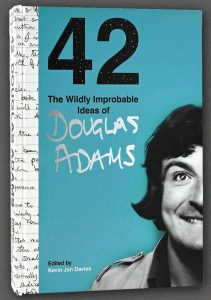A popular belief is that science will answer the big questions of the universe “what it all means” by a rigorous process of scientific investigation. But is that possible? What could such an answer possibly even look like, if it is to be in any way meaningful?

This is what Douglas Adams1 seemed to be pointing towards when his fictional supercomputer “Deep Thought” was asked to solve the ultimate question of “Life, the Universe and Everything“. The machine pondered for a moment and replied that the task was tricky, but that it could be done….just that it would take some time: seven and a half million years to be specific. And it did succeed. As we know. It was rather pleased with itself as it pronounced “The Answer to the Great Question of life the universe and everything, is… is… is…. Forty Two”.
It’s as though Adams is using humour to show how a rational, scientific, mathematical answer couldn’t actually make any human sense. Well, no more sense than the answer to life, the universe, and everything being “Forty Two”. Furthermore, that a huge amount of effort might be wasted getting close enough to realise how such an ultimate answer wouldn’t, in any sense, be satisfying.
But Seriously Though?

Philosophers, of course, have been troubled by the question of “Life, the Universe, and Everything” too. One of the “Greats”, Arthur Schopenhauer, published a volume in 18192 where he made a similarly dismissive argument to Adams’ “Forty Two”. Schopenhauer goes deep in his reasoning. But to skim, it runs something like this: the abstractions and general laws beloved of science necessarily abstract away and generalise to the outer form of things, all particulars are lost, and so we lose the actual meaningful content of nature.
Today, the mathematical physicist Stephen Wolfram3 seems to be making a similar point about reliance on mathematics to understand the world, because the actual detail of the world is generally far too complex for our maths to get a purchase upon – which is why maths gets so complicated so quickly. This means we end up focusing on those things which maths can do, and ignoring the bulk of reality that maths is ill-equipped to handle. Like the overused old joke4 of the drunk, looking under a street light for his keys, which he lost in a different dark street – but is searching for them under the street light because … that’s where the light is. Wolfram’s suggestion is that simulation is a better approach than maths as a basis to understand reality in all its actual uniqueness and complexity.
What has been achieved by our mathematically oriented understanding has been mesmerising – it’s led to iphones and atom bombs. But most of reality can’t be reduced beyond what it already is, down into mathematical abstractions. Take for example using mathematics to describe a city – you’d get statistics, flows of people, equations of growth or poverty – yet all the uniquely specific grubby details of particular shops, lives, loves, crimes and despair would be lost. Maybe Sim-City would be more illuminating? The worst case for the mathematical approach is that we’re just be absorbed with our mathematical cleverness, but which bears only small relation to the reality it seeks to explain.
That is a charge commonly levelled against the discipline of economics. Gary Stevenson, the economist, says that his post-graduate study of economics at Oxford was mostly about complex mathematics, yet few of those models and equations even took account of the distribution of wealth between rich and poor in society.
So maybe there’s some validity to the “Forty Two” attitude, as Adams, who was so deceptively profound in so many ideas, may well have known.
Schopenhauer summed up his point, much as Adams did:
“If we could actually succeed in this way, then an arithmetical sum would ultimately solve the riddle of the world”.
Arthur Schopenhauer, 1819
You may, or may not, agree with Adams or Schopenhauer. But by a curious coincidence, a few pages earlier in Schopenhauer’s work, we get the only bit of arithmetic mentioned in the whole 500+ pages, illustrating a quite different point, but which ends:…”=42″.
As “The Hitchhikers Guide” proclaims: “Probability factor one to one. Normality is restored…anything you still can’t cope with is your own problem“.
Adrian West
Footnotes
- In Douglas Adams “The Hitchhiker’s Guide to the Galaxy“, the earth is a giant supercomputer, designed by another supercomputer, ‘Deep Thought’, and created to understand what the “Ultimate Question of Life, the Universe, and Everything” really is. ↩︎
- Arthur Schopenhauer, “The World as Will and Representation“, Volume 1 (first edition 1819). Pages 144, and 75 in the E.F.J.Payne translation, Dover edition 1966. ↩︎
- Stephen Wolfram at Wikipedia. ↩︎
- By the early 20th Century German existential comedian, Kurt Valentin. ↩︎
Images
Photograph of Douglas Adam’s Grave at Highgate Cemetary: Pierre-Yves Beaudouin / Wikimedia Commons / CC BY-SA 4.0
Photograph of book “42: The Wildly Improbable Ideas of Douglas Adams”, Edited by Kevin Jon Davies, ISBN 978-1-80018-268-4. Published August 2023.
Portrait of Arthur Schopenhauer by Ludwig Sigismund Ruhl, 1815.
